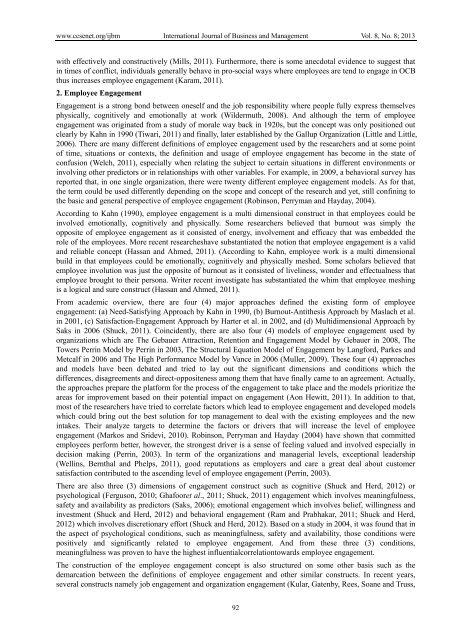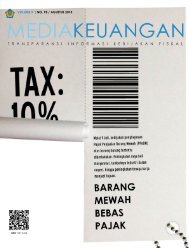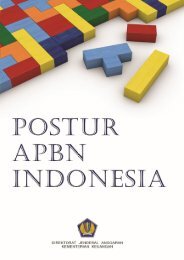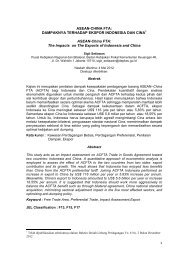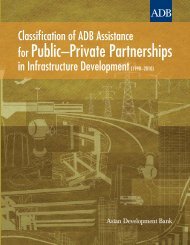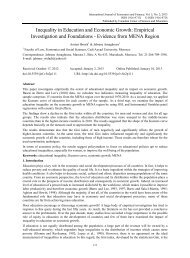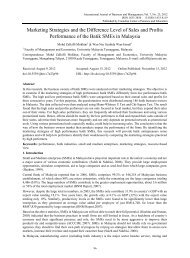The%20Effects%20of%20Perceived%20Leadership%20Styles%20and%20Organizational
The%20Effects%20of%20Perceived%20Leadership%20Styles%20and%20Organizational
The%20Effects%20of%20Perceived%20Leadership%20Styles%20and%20Organizational
Create successful ePaper yourself
Turn your PDF publications into a flip-book with our unique Google optimized e-Paper software.
www.ccsenet.org/ijbm International Journal of Business and Management Vol. 8, No. 8; 2013<br />
with effectively and constructively (Mills, 2011). Furthermore, there is some anecdotal evidence to suggest that<br />
in times of conflict, individuals generally behave in pro-social ways where employees are tend to engage in OCB<br />
thus increases employee engagement (Karam, 2011).<br />
2. Employee Engagement<br />
Engagement is a strong bond between oneself and the job responsibility where people fully express themselves<br />
physically, cognitively and emotionally at work (Wildermuth, 2008). And although the term of employee<br />
engagement was originated from a study of morale way back in 1920s, but the concept was only positioned out<br />
clearly by Kahn in 1990 (Tiwari, 2011) and finally, later established by the Gallup Organization (Little and Little,<br />
2006). There are many different definitions of employee engagement used by the researchers and at some point<br />
of time, situations or contexts, the definition and usage of employee engagement has become in the state of<br />
confusion (Welch, 2011), especially when relating the subject to certain situations in different environments or<br />
involving other predictors or in relationships with other variables. For example, in 2009, a behavioral survey has<br />
reported that, in one single organization, there were twenty different employee engagement models. As for that,<br />
the term could be used differently depending on the scope and concept of the research and yet, still confining to<br />
the basic and general perspective of employee engagement (Robinson, Perryman and Hayday, 2004).<br />
According to Kahn (1990), employee engagement is a multi dimensional construct in that employees could be<br />
involved emotionally, cognitively and physically. Some researchers believed that burnout was simply the<br />
opposite of employee engagement as it consisted of energy, involvement and efficacy that was embedded the<br />
role of the employees. More recent researcheshave substantiated the notion that employee engagement is a valid<br />
and reliable concept (Hassan and Ahmed, 2011). (According to Kahn, employee work is a multi dimensional<br />
build in that employees could be emotionally, cognitively and physically meshed. Some scholars believed that<br />
employee involution was just the opposite of burnout as it consisted of liveliness, wonder and effectualness that<br />
employee brought to their persona. Writer recent investigate has substantiated the whim that employee meshing<br />
is a logical and sure construct (Hassan and Ahmed, 2011).<br />
From academic overview, there are four (4) major approaches defined the existing form of employee<br />
engagement: (a) Need-Satisfying Approach by Kahn in 1990, (b) Burnout-Antithesis Approach by Maslach et al.<br />
in 2001, (c) Satisfaction-Engagement Approach by Harter et al. in 2002, and (d) Multidimensional Approach by<br />
Saks in 2006 (Shuck, 2011). Coincidently, there are also four (4) models of employee engagement used by<br />
organizations which are The Gebauer Attraction, Retention and Engagement Model by Gebauer in 2008, The<br />
Towers Perrin Model by Perrin in 2003, The Structural Equation Model of Engagement by Langford, Parkes and<br />
Metcalf in 2006 and The High Performance Model by Vance in 2006 (Muller, 2009). These four (4) approaches<br />
and models have been debated and tried to lay out the significant dimensions and conditions which the<br />
differences, disagreements and direct-oppositeness among them that have finally came to an agreement. Actually,<br />
the approaches prepare the platform for the process of the engagement to take place and the models prioritize the<br />
areas for improvement based on their potential impact on engagement (Aon Hewitt, 2011). In addition to that,<br />
most of the researchers have tried to correlate factors which lead to employee engagement and developed models<br />
which could bring out the best solution for top management to deal with the existing employees and the new<br />
intakes. Their analyze targets to determine the factors or drivers that will increase the level of employee<br />
engagement (Markos and Sridevi, 2010). Robinson, Perryman and Hayday (2004) have shown that committed<br />
employees perform better, however, the strongest driver is a sense of feeling valued and involved especially in<br />
decision making (Perrin, 2003). In term of the organizations and managerial levels, exceptional leadership<br />
(Wellins, Bernthal and Phelps, 2011), good reputations as employers and care a great deal about customer<br />
satisfaction contributed to the ascending level of employee engagement (Perrin, 2003).<br />
There are also three (3) dimensions of engagement construct such as cognitive (Shuck and Herd, 2012) or<br />
psychological (Ferguson, 2010; Ghafooret al., 2011; Shuck, 2011) engagement which involves meaningfulness,<br />
safety and availability as predictors (Saks, 2006); emotional engagement which involves belief, willingness and<br />
investment (Shuck and Herd, 2012) and behavioral engagement (Ram and Prabhakar, 2011; Shuck and Herd,<br />
2012) which involves discretionary effort (Shuck and Herd, 2012). Based on a study in 2004, it was found that in<br />
the aspect of psychological conditions, such as meaningfulness, safety and availability, those conditions were<br />
positively and significantly related to employee engagement. And from these three (3) conditions,<br />
meaningfulness was proven to have the highest influentialcorrelationtowards employee engagement.<br />
The construction of the employee engagement concept is also structured on some other basis such as the<br />
demarcation between the definitions of employee engagement and other similar constructs. In recent years,<br />
several constructs namely job engagement and organization engagement (Kular, Gatenby, Rees, Soane and Truss,<br />
92


